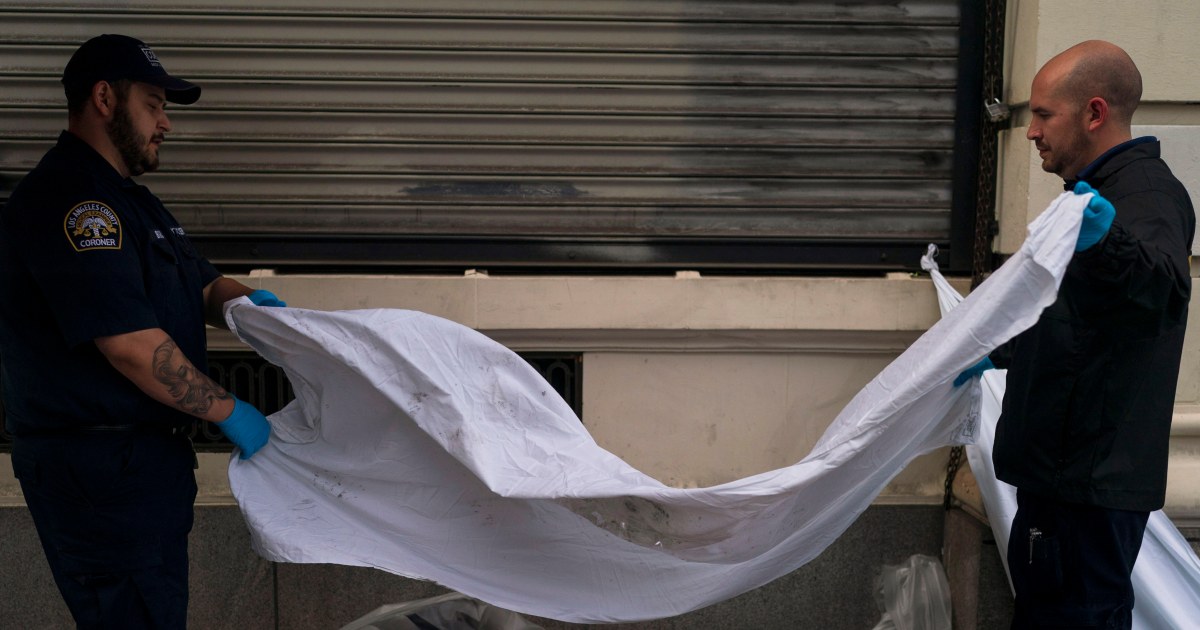By Mike Stobbe - The Associated Press
Drug overdose deaths in the United States rose slightly last year, after two big jumps during the coronavirus pandemic.
Officials at the Centers for Disease Control and Prevention (CDC) say the numbers stagnated for most of last year. Experts aren't sure if that means the deadliest drug overdose epidemic in U.S. history has finally peaked, or if it will resemble previous plateaus followed by new death surges
[Overdose deaths hit all-time high in 2021 and pandemic isn't just to blame]
"The fact that it seems to be flattening, at least nationally, is encouraging," said Katherine Keyes, a Columbia University professor of epidemiology whose research focuses on drug use. "But these numbers are still extraordinarily high. We should not suggest that the crisis is over by any means."
Assistant Coroner Laurentiu Bigu, left, and investigator Ryan Parraz of the Los Angeles County coroner's office cover the body of a homeless person found dead on a sidewalk in Los Angeles on April 18, 2022. The 60-year-old man died from the effects of methamphetamine, according to the autopsy report. Jae C. Hong / AP
An estimated 109,680 overdose deaths occurred last year, according to figures released Wednesday by the CDC. That's about 2% more than the 107,622 overdose deaths in the U.S. in 2021, but nothing like the 30% increase seen in 2020 and the 15% increase in 2021.
While the overall national figure remained relatively static between 2021 and 2022, there were dramatic changes in several states: 23 reported fewer overdose deaths, one, Iowa, saw no change, and the rest continued to rise.
[More Fentanyl-Tainted Marijuana in U.S.: Authorities Warn of Increase]
Eight states (Florida, Indiana, Kentucky, Maryland, Michigan, Ohio, Pennsylvania and West Virginia) reported significant decreases in overdose deaths of about 100 or more compared to the previous calendar year.
Some of these states had some of the highest overdose death rates during the epidemic, which Keyes said could be a sign that years of concentrated work to address the problem are paying off.
Fentanyl Overdose Deaths Increased Nearly 300% in Seven Years
May 3, 202300:23
Why didn't deaths increase as much as before?
State officials cited several factors in the decline, including health education campaigns to warn the public about the dangers of drug use; expanded addiction treatment, including telehealth, and wider distribution of the drug naloxone to reverse overdoses.
In addition, the stigma that prevented drug users from seeking help, and some doctors and police from helping them, is diminishing, said Dr. Joseph Kanter, a health official for the state of Louisiana, where overdose deaths fell 4% last year.
[The opioid crisis isn't just a white problem: Deaths among Hispanics have skyrocketed]
"We're catching up and the tide is turning, slowly," said Kanter, whose state has one of the highest overdose death rates in the country.
Beginning in the mid-1990s, prescription opioid painkiller abuse was to blame for deaths before a gradual switch to heroin, which in 2015 caused more deaths than prescription painkillers or other drugs. A year later, the more lethal fentanyl and its close cousins became the most killer drugs.
U.S. Calls Mixing Fentanyl with Veterinary Tranquilizer an "Emerging Threat"
April 12, 202300:29
Last year, most overdose deaths continued to be linked to fentanyl and other synthetic opioids. About 75,000, up 4% from the previous year. There was also an 11% increase in cocaine-related deaths and a 3% increase in deaths related to methamphetamine and other stimulants.
[Purdue Pharma admits criminal guilt in opioid epidemic over OxyContin]
Overdose deaths are often attributed to more than one drug; Some people take multiple drugs and officials say cheap fentanyl is increasingly used in the manufacture of other drugs, often without the buyers' knowledge.
Research by Dr. Daniel Ciccarone, a drug policy expert at the University of California, San Francisco, suggests that "there seems to be some substitution": that a number of people who use illicit drugs turn to methamphetamines or other options to try to stay away from fentanyl and drugs more likely to be contaminated with fentanyl.
Ciccarone said he believes overdose deaths will eventually decline. He cited improvements in innovations in addiction screening and treatment, improved availability of naloxone and lawsuits that led to more than $50 billion in proposed and finalized legal settlements, money that should be available to bolster overdose prevention.
[The new drug mix that makes the "deadliest substance the country has ever faced, fentanyl, even more lethal."]
"We've launched all kinds of solutions to this 20-year-old opioid overdose problem," he said. "We should be able to bend the curve down."
But he also expressed some caution, saying "we've been here before."
After the fall, the rebound
Consider 2018, when overdose deaths fell 4% from the previous year, to about 67,000. After those numbers came out, then-President Donald Trump declared, "We're slowing the opioid epidemic."
When you think you have it under control, sometimes the problem can change in new and different ways."
Katherine Keyes PROF. of EPIDEMIOLOGY AND DRUG USE, COLUMBIA UNIVERSITY
But overdose deaths then rose to a record 71,000 in 2019, then skyrocketed during the COVID-19 pandemic to 92,000 in 2020 and then to 107,000 in 2021.
Pandemic-era quarantines and other restrictions isolated people with drug addictions and made it difficult to access treatment, experts have said.
Keyes believes the 2022 numbers didn't get worse in part because isolation eased as the pandemic took its toll.
But there may be problems down the road, others say: Increased detection of the veterinary tranquilizer xylazine (known as tranq) in illicit drug supply, and proposals have emerged to reduce services such as prescribing addiction medications through telehealth.
"What the last 20 years of this overdose crisis have taught us is that this is really a moving target," Keyes said. "And when you think you've got it under control, sometimes the problem can change in new and different ways."

